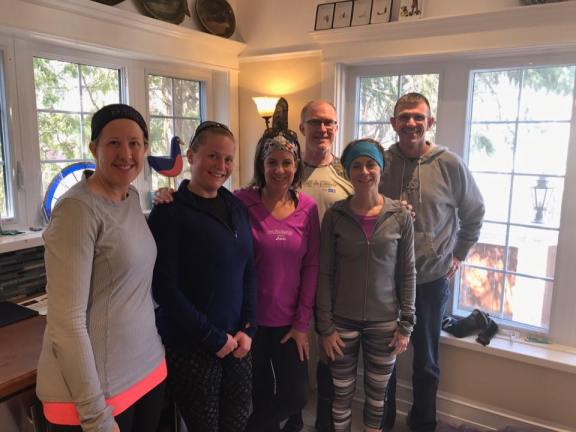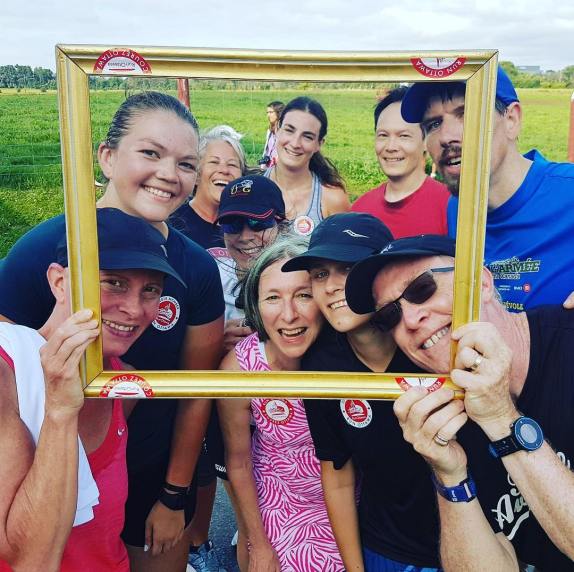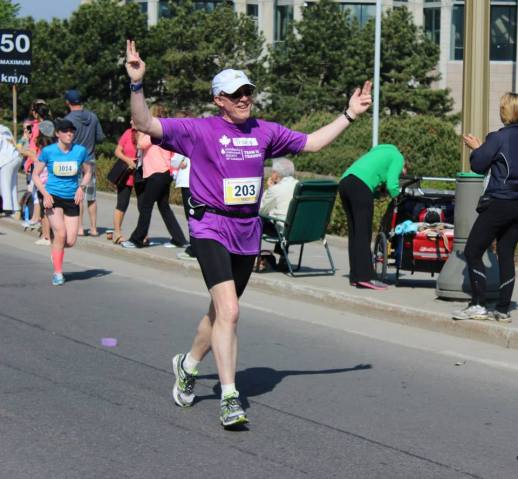Hello all! It’s been a while since I’ve posted. But it’s January – the time of year when all runners start to turn their attention to the spring racing season. Ottawa is no exception: despite the -40C windchill outside today, you’re all starting to consider the road to Tamarack Ottawa Race Weekend (TORW). And many of you start your training plan in the next week or two.
Full disclosure: I started running relatively late in life compared to most – I ran my first half in 2010, at the age of 46. Since then, I’ve run many halfs … 14 that are officially documented on Sportstats, a couple of Hypothermic Halfs (that aren’t on Sportstats), and a few out-of-country “destination” halfs (Red Rock Canyon, Dublin, and Richmond, VA). I’ve also notched three full marathons (Ottawa twice, and Chicago once). I’ve run halfs in -30C windchills (see “hypothermic” above) and in 35C humidexes (especially the Army Half of 2016 – ugh!) … so you could say that I’m “battle-hardened.”

It was -25C, before windchill, when I ran this Hypothermic Half a few years back. My mouth is open; I’m likely swearing.
I thought that as a public service, I’d post a few tips, especially for those who are attempting their first half in 2019. Most of these also apply if you are training for a full; both are distance runs, and a degree of discipline and planning is required if you wish to finish the race and be happy with the result.
So here they are, in no particular order – with the caveat that I am neither a trainer nor a nutritionist. “Your mileage may vary.”
GOAL-SETTING & PLANNING
Set a realistic goal. A good rule of thumb, if you don’t know what’s reasonable, would be to take your typical 10k finish time, double it, and then add about 20 minutes. Are you a 50-minute 10k runner? Then 50×2 = 100, plus 20 = 120 minutes. So you could reasonably expect to finish a half in two hours. Put another way: if you have never done a 50-minute 10k, do not try a sub-2:00 half, because you will likely end the race disappointed in the result – and maybe in yourself. And who wants that? If you want to try something a bit more scientific, you can consult the free McMillan Running Calculator. If you have a good sense of what your typical 10k time is, you can enter it and the calculator will spit out your expected pace/splits for a half. It’s pretty good.

Create a plan. You can get these online, or you can consult a running coach. I can tell you, based on my experience, that for a half you’ll need to do at least three runs a week: an intervals run (where you run at challenging/fast paces for multiple, short distances); a tempo run (a “comfortably hard” pace that you could sustain for about an hour), and a long/slow run (where you deliberately run comfortably and more slowly than your race pace, for progressively longer distances as you train). If you can fit in a fourth run per week (typically a second tempo run), so much the better. Everyone is different, but the weekly cadence that worked most effectively for me was:
- Tuesday: intervals (typically about 45 minutes in total, comprising many sets of intervals with rest periods built in). Interval pace can vary from your race pace, to faster-than-your-5k pace.
- Thursday: tempo run (typically about 50 minutes).
- Saturday: tempo run (typically about 40-45 minutes) – or strength work (see below).
- Sunday: long/slow run (distance based – build up from a 10k base and get up to about 20k).
If you have the time, work strength training into your off days. Especially core and upper-body, because these parts of your body will get you through the last 2km or so, when your legs start to give up the ghost and the lactic acid takes its toll. Someone once told me that your legs will get you most of the way, but your core and upper body will see you to the finish line. If you only have four days per week to work out, I would personally recommend only three runs (i.e., drop a tempo run) so you can do strength on the fourth day.
Commit to – and stick to – the plan. You simply can’t skip training runs, if you want to meet your goal. This is an endurance event you are training for – so you can’t get away with good intentions – you’ve gotta do the time. The only exceptions here would be an injury or some sort of significant illness. Otherwise, do the runs – all of them. If the weather is bad, find a treadmill. If you are under the weather, but not totally down & out, try to do the run, but perhaps a bit shorter or with a bit less intensity. Get to a point where the weekly run cadence is engrained in your head and immutable.
Plan the run, and run the plan. I cannot overstate the importance of this one, simple piece of wisdom. In running circles, people regularly say it – but not many of us heed it, especially in the first big race. Having diligently having trained for the race, we explode with enthusiasm and burst out of the start like we are Captain America, at least 30s/km faster than we’ve ever run in our lives. In a 5k or 10k race, that will definitely come back to bite you – but you’ll get away with it, and probably finish. For a half or full, however, you could actually blow up and not finish the race. If your plan is geared toward a 6:00/km average pace, force yourself – especially in the first 3km – to run no faster than that pace. Trust me: watch your GPS like a hawk, and trust the plan and your training.

The 2012 Scotiabank Half-Marathon in Toronto. My (fairly ambitious – but achievable) goal was 1:40:00 or less. The clock here reflected gun time, not my time. I finished in 1:39:53, thanks to committing to my goal, watching my pace (note Garmin GPS on left wrist) and sticking with my training. And I also acknowledge my coach yelling at me on course.
Be careful with your long/slow run distance. As a rule of thumb, you should not increase the distance of a long run by more than 10% or so in any given week. Otherwise, you risk injury. You may want to push it a bit, at first, but trust me: your long runs will eventually get long enough – so be patient!
Long/slow runs are just that: long, SLOW runs. I made this mistake in my early training. I ran all my long runs at roughly race pace. It felt like I could, so I did. I remember my coach, after reviewing my training log, telling me something along the lines of, “you can’t run all your runs at race pace – would you normally run a race four times in a week?” Again, you’ll risk injury by doing this. Personally, my slow pace ended up being about 20s/km slower than my goal pace.

Long … SLOW … runs.
GADGETS & MUSIC
If possible, get a GPS watch. You can’t know how you are doing if you don’t check in regularly vs. your goal pace. Having a GPS watch is your best chance of staying on target. If you don’t currently have one and can afford it, buy one; if not, perhaps borrow one from a friend … and train with it. Many runners use their phone’s GPS, but I would caution that phones can be inaccurate at times: based on my friends’ anecdotal experience, mobile phone apps tend to overstate your pace and/or distance a bit (i.e., making you think you ran more quickly and/or longer than you actually did). But a phone GPS is better than no GPS.
Or, go low-tech. If a GPS isn’t in the cards, you can purchase a pace band that shows elapsed time for each kilometre of your run, for a given distance and goal time (you can get these at most running stores like Running Room). With a pace band, you can check progress against your watch based on elapsed time for a given distance, instead of having to check pace in the moment. The downside of this approach is that you’ll have fewer opportunities to “check in” … and it could be a bit trickier to correct if you drift from the plan, because you find out later.
Consider no music. I fully realize that some runners would call this heresy. I personally do not listen to music when I run. I eschew tunes because I like to clear my head while running, and I like to listen to my foot cadence and breathing as part of that experience. It’s really my only chance to “zone out” and be a bit mindful, and I take full advantage. It is also a safer practice – because you will not be distracted by music when running and can readily hear other runners, approaching bikes, cars, etc. I realize you may not subscribe to this philosophy, but perhaps try it sometime. Plus, if you adopt this approach, on race day you’ll get to hear all the people cheering – there’s nothing better!
THE PHYSICAL STUFF
Learn to use fuel. Experiment during training with different types of fuel. I prefer chews (similar to gummies), but some prefer gels or the newer maple syrup-based products that provide the needed energy/carbs to get you to the finish. In the early days of your training, experiment a bit on your long runs, and find what suits you best. Then stick with what works for the balance of your training and for race day. I would generally use between one and two packs of chews for a half (e.g., take a few chews 15 minutes before you start, and then a few at the 6k, 12k and 18k points). NOTE: fuel is NOT something you should try the first time on race day; you have to have used it prior, so you know that it will not affect your gastro system.
Ditto hydration. Most of us bring water with us on long runs. For organized races, water stations are usually found every 4km or so so you don’t have to carry it. But be sure you are rehydrating enough. The rule of thumb is, if you feel thirsty it’s already too late – but drink only to thirst and no more. As you train, you’ll learn how much and how often.
And, electrolytes. Your chews or gels may have electrolytes; and often on course you’ll be offered either water or electrolyte drinks at water stations. Just make sure you’re getting some, to replenish what the sodium and potassium you lose from sweat. If you don’t, you may end up with some unwelcome cramping late in the race.
Don’t get adventurous with diet. Find what works best for your long run. Not just what you eat, but how long before your run you do so. For me, it’s oatmeal with brown sugar and a small black coffee, a couple of hours before gun time. You want to ensure that you work anything through your system well before gun time. Once you find something that works, don’t mess with it! Do the same thing, at the same time, every time. Boring? Perhaps. But you won’t find yourself in GI distress come race day.
Listen to your body. If something starts to hurt, don’t fight it. Dial back the distance, volume or intensity, and see if the pain goes away. If not, talk to a physiotherapist and address the issue. Note that there is a difference between “aches” and “pain” … if it aches, that’s normal: your body learning to achieve new limits and you should press on. If there is pain, that’s a problem, and needs to be addressed (see, “PT and RMT” below).
Get to know your PT and RMT. This is obviously a function of how much you can afford; but if you can afford to consult a physiotherapist for rehabilitation (if you feel pain), then do so. If you can afford massage therapy every 4-6 weeks, schedule it in. Note: IMHO, the best massage is one that actually hurts (i.e., deep-tissue massage, not the light stuff). Try to get PTs/RMTs who understand running and the typical issues that runners have (e.g., tight IT band, sore Achilles tendon, tight calves, plantar fasciitis, etc.).
ATTITUDE
Find some friends for the long/slow runs. There are two reasons for this: (i) they are long runs, so having friends along helps pass the time and make it fun; and (ii) it creates a sense of joint accountability: it’s harder to blow off a run if you know others are expecting you. Your friends will also egg you along on some of those more … “character-building” long runs when you just can’t find what you need to finish. If you don’t have a group of friends who run or are new to the area, consider joining the free runs run by Running Room or Run Ottawa – trust me, you’ll meet new friends!
This is my Sunday Run Club – a great crew that I’ve logged countless miles with. Below that are some of my Run Ottawa crew – people I run with at many local races, and practice with on Thursday evenings. They are all among my best friends.

Some of my Sunday Run Club buddies. We log the long miles, together, all year round on Sunday mornings. Great runners … great people … and great friends.

Some of the Run Ottawa crew, with whom I run at numerous races year-round, and practice on Thursday evenings. Yes, there is beer.
Be prepared for the suckage. I’m not going to lie: if you are running a half … even if you’ve trained well for it … the last 2-3km (and maybe more) will suck. If you are running a full, the last 5-7km (and maybe more) will suck. This WILL happen. So you must be mentally prepared for it. Here are some tips to help you get past “the wall” and finish the job:
- Leverage the free energy. If you are in a race with spectators, embrace them. Say thank you, high-five people, gesture to them to get them cheering louder (I promise you, they will!). They are there to help you!
- Train up for the distance. I’ve covered this elsewhere, but for a half, make sure you’ve done a long run of 20km. For a full, you have to be careful: go up to 35km but don’t push it (you would not want to injure yourself as you get close to your race!). Pace doesn’t matter for these runs … it’s about “time on feet” or “junk miles” or whatever you want to call it.
- Play mental games, to pass the time. I will (for example) pick a signpost or other object up ahead, and try to guess how many paces it will take me to get there. See how close you can guess; and then do it again with another object in the distance. This will occupy your brain (because you have to count the paces). Or try to run a certain number of steps, exactly, in a minute – again, to keep your brain busy and occupy your mind while keeping on going. If you are a bit more aggressive, you can pick a runner ahead of you and make it your goal to pass that runner. Then pick another. And so on.
- Try not to walk. It’s really difficult to get running again, once your brain gives your legs “permission” to walk that first time. It is far preferable to just slow down to a shuffle, than to walk – because you’ll keep the running motion going.
- Check in on your form. When things start to get tough, do a mental checklist of your form from time to time. Is my head up? Shoulders back & chest expanded (expanded lungs = more oxygen to the blood & muscles)? Core engaged? Slight body lean forward (but from the ankles, not the waist)? Just going through this checklist will help you recover from slumping, and it will make you feel stronger. It will also keep your brain busy/engaged.
- If using a phone, play music that amps you up! As I state above, I don’t play music myself … but if you are, find something that cranks you up and play it.
Finally – and I purposefully put this last – HAVE FUN. This is your first half (or full). It would be a shame only to focus on the end result, and not the journey! Have fun on your long runs and meet new friends. Challenge yourself to new bests when doing intervals. On race day, soak in the pre-race vibe. Say hi to the folks around you in the corral. Smile – not just when near a photographer, but throughout the run. Look around, soak in the sights, and relish the fact that you are able to run in the first place. Thank the volunteers. High-five the kids who have been waiting to watch you run by. Congratulate those around you at the finish. And enjoy that bagel and banana – YOU DID IT.

Ottawa Marathon, 2014. This was at the 17k point. I tried – successfully – to whoop up the crowd. They were very obliging!
I hope you find some value from the tips above. Finishing your first half or full is a life milestone that you will never forget. And it’s something that precious few of us achieve – so be proud!
I’d love to hear from anyone who wants to share their experience and tips – just comment below 🙂
–Tracy
